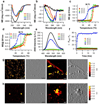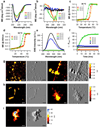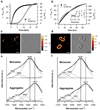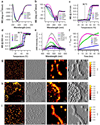The glaucoma-associated olfactomedin domain of myocilin forms polymorphic fibrils that are constrained by partial unfolding and peptide sequence
- PMID: 24333014
- PMCID: PMC3946817
- DOI: 10.1016/j.jmb.2013.12.002
The glaucoma-associated olfactomedin domain of myocilin forms polymorphic fibrils that are constrained by partial unfolding and peptide sequence
Abstract
The glaucoma-associated olfactomedin domain of myocilin (myoc-OLF) is a recent addition to the growing list of disease-associated amyloidogenic proteins. Inherited, disease-causing myocilin variants aggregate intracellularly instead of being secreted to the trabecular meshwork, which is a scenario toxic to trabecular meshwork cells and leads to early onset of ocular hypertension, the major risk factor for glaucoma. Here we systematically structurally and biophysically dissected myoc-OLF to better understand its amyloidogenesis. Under mildly destabilizing conditions, wild-type myoc-OLF adopts non-native structures that readily fibrillize when incubated at a temperature just below the transition for tertiary unfolding. With buffers at physiological pH, two main endpoint fibril morphologies are observed: (a) straight fibrils common to many amyloids and (b) unique micron-length, ~300 nm or larger diameter, species that lasso oligomers, which also exhibit classical spectroscopic amyloid signatures. Three disease-causing variants investigated herein exhibit non-native tertiary structures under physiological conditions, leading to a variety of growth rates and a fibril morphologies. In particular, the well-documented D380A variant, which lacks calcium, forms large circular fibrils. Two amyloid-forming peptide stretches have been identified, one for each of the main fibril morphologies observed. Our study places myoc-OLF within the larger landscape of the amylome and provides insight into the diversity of myoc-OLF aggregation that plays a role in glaucoma pathogenesis.
Keywords: AFM; ANS; ER; FTIR; Fourier transform infrared spectroscopy; TEV; TM; ThT; amyloid; anilinonaphthalene-1-sulfonate; atomic force microscopy; circular dichroism; endoplasmic reticulum; protein misfolding; protein structure; thioflavin T; tobacco etch virus; trabecular meshwork.
Copyright © 2013 Elsevier Ltd. All rights reserved.
Figures





Similar articles
-
The stability of myocilin olfactomedin domain variants provides new insight into glaucoma as a protein misfolding disorder.Biochemistry. 2011 Jul 5;50(26):5824-33. doi: 10.1021/bi200231x. Epub 2011 Jun 9. Biochemistry. 2011. PMID: 21612213 Free PMC article.
-
The glaucoma-associated olfactomedin domain of myocilin is a novel calcium binding protein.J Biol Chem. 2012 Dec 21;287(52):43370-7. doi: 10.1074/jbc.M112.408906. Epub 2012 Nov 5. J Biol Chem. 2012. PMID: 23129764 Free PMC article.
-
Molecular Insights into Myocilin and Its Glaucoma-Causing Misfolded Olfactomedin Domain Variants.Acc Chem Res. 2021 May 4;54(9):2205-2215. doi: 10.1021/acs.accounts.1c00060. Epub 2021 Apr 13. Acc Chem Res. 2021. PMID: 33847483 Free PMC article. Review.
-
Structural basis for misfolding in myocilin-associated glaucoma.Hum Mol Genet. 2015 Apr 15;24(8):2111-24. doi: 10.1093/hmg/ddu730. Epub 2014 Dec 18. Hum Mol Genet. 2015. PMID: 25524706 Free PMC article.
-
Age at Glaucoma Diagnosis in Germline Myocilin Mutation Patients: Associations with Polymorphisms in Protein Stabilities.Genes (Basel). 2021 Nov 16;12(11):1802. doi: 10.3390/genes12111802. Genes (Basel). 2021. PMID: 34828408 Free PMC article. Review.
Cited by
-
Quantitative differentiation of benign and misfolded glaucoma-causing myocilin variants on the basis of protein thermal stability.Dis Model Mech. 2023 Jan 1;16(1):dmm049816. doi: 10.1242/dmm.049816. Epub 2023 Jan 13. Dis Model Mech. 2023. PMID: 36579626 Free PMC article.
-
Antibodies Used to Detect Glaucoma-Associated Myocilin: More or Less Than Meets the Eye?Invest Ophthalmol Vis Sci. 2019 May 1;60(6):2034-2037. doi: 10.1167/iovs.19-26843. Invest Ophthalmol Vis Sci. 2019. PMID: 31067323 Free PMC article. Review.
-
Myocilin misfolding and glaucoma: A 20-year update.Prog Retin Eye Res. 2023 Jul;95:101188. doi: 10.1016/j.preteyeres.2023.101188. Epub 2023 May 20. Prog Retin Eye Res. 2023. PMID: 37217093 Free PMC article. Review.
-
Structure‒function‒pathogenicity analysis of C-terminal myocilin missense variants based on experiments and 3D models.Front Genet. 2022 Oct 4;13:1019208. doi: 10.3389/fgene.2022.1019208. eCollection 2022. Front Genet. 2022. PMID: 36267417 Free PMC article.
-
Different Grp94 components interact transiently with the myocilin olfactomedin domain in vitro to enhance or retard its amyloid aggregation.Sci Rep. 2019 Sep 4;9(1):12769. doi: 10.1038/s41598-019-48751-8. Sci Rep. 2019. PMID: 31484937 Free PMC article.
References
-
- Stone EM, Fingert JH, Alward WL, Nguyen TD, Polansky JR, Sunden SL, Nishimura D, Clark AF, Nystuen A, Nichols BE, Mackey DA, Ritch R, Kalenak JW, Craven ER, Sheffield VC. Identification of a gene that causes primary open angle glaucoma. Science. 1997;275:668–670. - PubMed
-
- Gobeil S, Rodrigue M-A, Moisan S, Nguyen TD, Polansky JR, Morissette J, Raymond V. Intracellular sequestration of hetero-oligomers formed by wild-type and glaucoma-causing myocilin mutants. Invest. Ophthalmol. Vis. Sci. 2004;45:3560–3567. - PubMed
-
- Joe MK, Sohn S, Hur W, Moon Y, Choi YR, Kee C. Accumulation of mutant myocilins in ER leads to ER stress and potential cytotoxicity in human trabecular meshwork cells. Biochem. Biophys. Res. Commun. 2003;312:592–600. - PubMed
-
- Zhou Z, Vollrath D. A cellular assay distinguishes normal and mutant TIGR/myocilin protein. Hum. Mol. Genet. 1999;8:2221–2218. - PubMed
Publication types
MeSH terms
Substances
Grants and funding
LinkOut - more resources
Full Text Sources
Other Literature Sources
Miscellaneous

